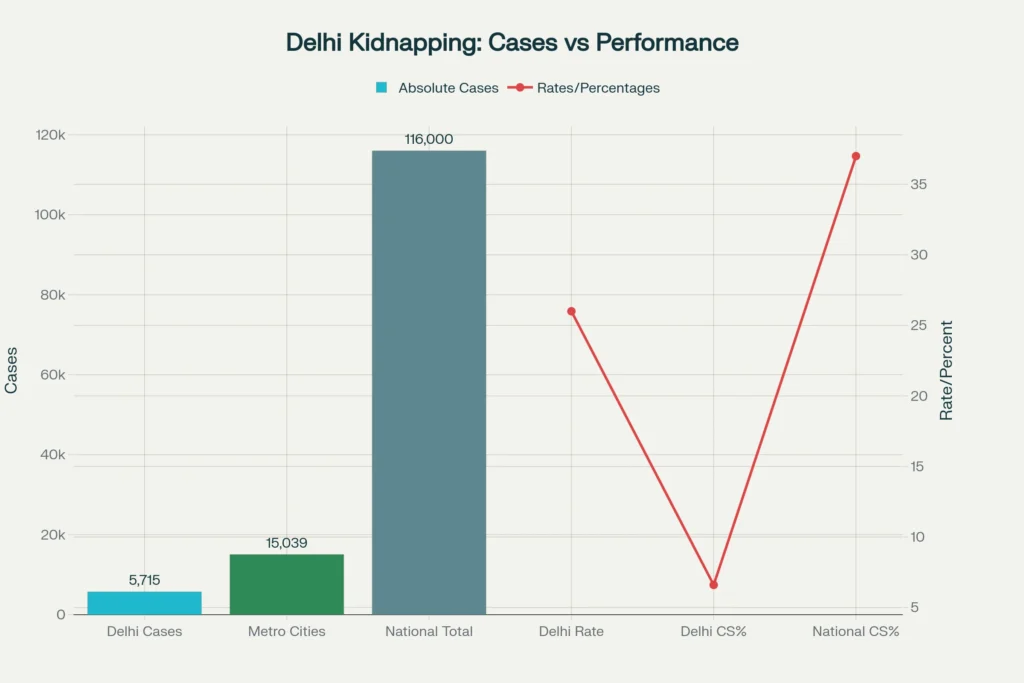Key Highlights:
- Over 116,000 kidnapping and abduction cases reported nationwide in 2023, marking a 5.6% increase from previous year
- Delhi recorded highest crime rate with 5,715 cases and poor 6.6% charge sheet rate among all states and UTs
- Children comprised 70% of victims with 18,000 cases linked to elopement involving equal numbers of minors and adults
Rising Crime Trends Expose National Security Concerns
India witnessed an alarming surge in kidnapping statistics India during 2023, with over 116,000 incidents reported across the country according to the National Crime Records Bureau (NCRB). This represents a significant 5.6% increase from the 107,588 cases registered in 2022, highlighting growing concerns about personal safety and law enforcement effectiveness. The kidnapping statistics India reveal disturbing patterns that demand immediate attention from policymakers and security agencies nationwide.
The comprehensive NCRB data shows that kidnapping statistics India have reached unprecedented levels, with Delhi emerging as the most problematic region. These statistics underscore the urgent need for enhanced preventive measures and improved investigation protocols. The rising trend of kidnapping and abduction incidents poses serious questions about public safety infrastructure and the effectiveness of current crime prevention strategies based on kidnapping statistics India.
Delhi Emerges as National Hotspot for Kidnapping Crimes
- Delhi recorded 5,715 kidnapping and abduction cases with a crime rate of 26 per 100,000 population
- The national capital showed an abysmal charge sheet rate of only 6.6% in such cases
Delhi’s performance in handling kidnapping and abduction cases presents the worst picture among all states and union territories across India. With 5,715 registered cases, the capital territory recorded the highest absolute numbers and maintained a concerning crime rate of 26 per lakh population. This data positions Delhi as a critical concern area requiring immediate intervention from law enforcement agencies, reflecting poorly in kidnapping statistics India.
The charge sheet rate of merely 6.6% in Delhi’s kidnapping and abduction cases indicates severe deficiencies in investigation procedures and case resolution mechanisms. This poor performance rate suggests that despite high case registration numbers, the judicial process remains ineffective in addressing these crimes. The combination of high crime incidence and low conviction rates creates an environment where kidnapping and abduction perpetrators face minimal consequences for their actions, worsening kidnapping statistics India.
Metropolitan cities with populations exceeding one million reported 15,039 kidnapping and abduction cases during 2023, representing a 7.5% increase from the previous year’s 13,984 cases. This urban concentration of crimes suggests that densely populated areas require specialized attention and resources to combat kidnapping and abduction effectively, as reflected in kidnapping statistics India.
Crime against women was highest in Delhi with over 13,000 cases registered in 2023 alone, as the national Capital recorded the highest number of dowry deaths and rape cases among 19 metropolitan cities pic.twitter.com/0sb2ywFcwZ
— SK Iyer (@iyer_sk) October 1, 2025
Demographic Patterns Reveal Vulnerable Population Groups
- Children constituted 70% of kidnapping and abduction victims with 82,106 cases involving minors
- Among adult victims, 75% were females, indicating gender-based vulnerability patterns
The demographic breakdown of kidnapping and abduction victims reveals concerning patterns that highlight specific population vulnerabilities in kidnapping statistics India. Children dominated the victim statistics, comprising 82,106 of the total cases, with 66,072 being female children and 16,033 male children. This overwhelming representation of minors in kidnapping and abduction cases indicates systematic targeting of vulnerable populations.
Adult victims totaled 34,298 cases, with women representing 26,042 of these incidents compared to 8,252 male victims. This gender disparity in kidnapping statistics India suggests that women face disproportionate risks and require enhanced protection measures. The data also recorded four transgender adults among the victims, highlighting the need for inclusive safety protocols.
The recovery statistics show that approximately 68% of kidnapped persons were eventually found, with 140,813 individuals recovered during 2023. However, 66,268 victims remained unrecovered, representing a significant concern for families and law enforcement agencies. Among those recovered, 139,164 persons were found alive while 1,649 were discovered dead, underscoring the life-threatening nature of kidnapping and abduction crimes reflected in kidnapping statistics India.

Elopement Cases Dominate Kidnapping Motivations
- Nearly 18,000 kidnapping and abduction cases involved elopement, equally split between children and adults
- Marriage-related abductions affected 32,656 individuals, making it the primary motive for these crimes
Elopement emerged as a significant factor in kidnapping statistics India, accounting for approximately 18,000 incidents involving 9,251 children and 8,853 adults. This category represents cases where individuals left their homes voluntarily to be with romantic partners, often resulting in family complaints and police investigations. The equal distribution between children and adults in elopement-related kidnapping and abduction cases indicates that romantic relationships transcend age boundaries in driving these statistics.
Kidnapping and abduction for marriage purposes affected 32,656 individuals, including 16,866 children and 15,790 adults, making it the most prominent reason for these crimes in kidnapping statistics India. This data reveals deeply rooted social issues surrounding arranged marriages, family consent, and individual autonomy in relationship choices. The prevalence of marriage-related kidnapping and abduction cases suggests cultural conflicts between traditional family structures and modern relationship dynamics.
Additional motivations included unlawful activities, which accounted for 1,958 cases involving 1,218 children and 740 adults. Recovery investigations revealed that 9,161 children and 6,413 adults had left home voluntarily due to family conflicts or parental scolding, indicating that domestic situations sometimes contribute to kidnapping statistics India case registrations.
Judicial System Struggles with Case Resolution
The disposal rate of kidnapping and abduction cases remains critically low, with only 37% of 180,591 cases under investigation resulting in charge sheets. This poor performance indicates systemic issues within the criminal justice system’s ability to process these crimes effectively according to kidnapping statistics India. The conviction rate presents an even more concerning picture, with merely 20.2% of the 351,090 cases before courts ending in accused convictions.
These statistics highlight significant gaps in the investigation and prosecution of kidnapping and abduction cases. The low charge sheet rate suggests that evidence collection and case preparation procedures require substantial improvements in kidnapping statistics India. Similarly, the poor conviction rates indicate that even when cases reach courts, successful prosecution remains challenging due to various procedural and evidentiary issues.
The recovery data shows some positive outcomes, with 15,181 persons recovered in metropolitan cities alone, including 15,167 found alive and 14 discovered dead. However, the overall system performance in preventing, investigating, and prosecuting kidnapping and abduction cases needs comprehensive reforms to ensure justice for victims and their families, as indicated by kidnapping statistics India.
Final Assessment of India’s Kidnapping Crisis
The 2023 NCRB data on kidnapping statistics India presents a sobering picture of the country’s public safety challenges. With over 116,000 reported incidents representing a continued upward trend, the country faces a crisis that demands immediate and comprehensive action. The concentration of cases in urban areas, particularly Delhi, highlights the need for targeted interventions in high-risk regions based on kidnapping statistics India.
The demographic vulnerabilities revealed through these kidnapping statistics India call for specialized protection programs for children and women. The prevalence of elopement and marriage-related cases suggests that social reforms addressing family dynamics and individual rights could significantly impact crime reduction. Most critically, the poor investigation and conviction rates indicate that systemic judicial reforms are essential to create deterrent effects and ensure justice delivery in kidnapping statistics India cases.


